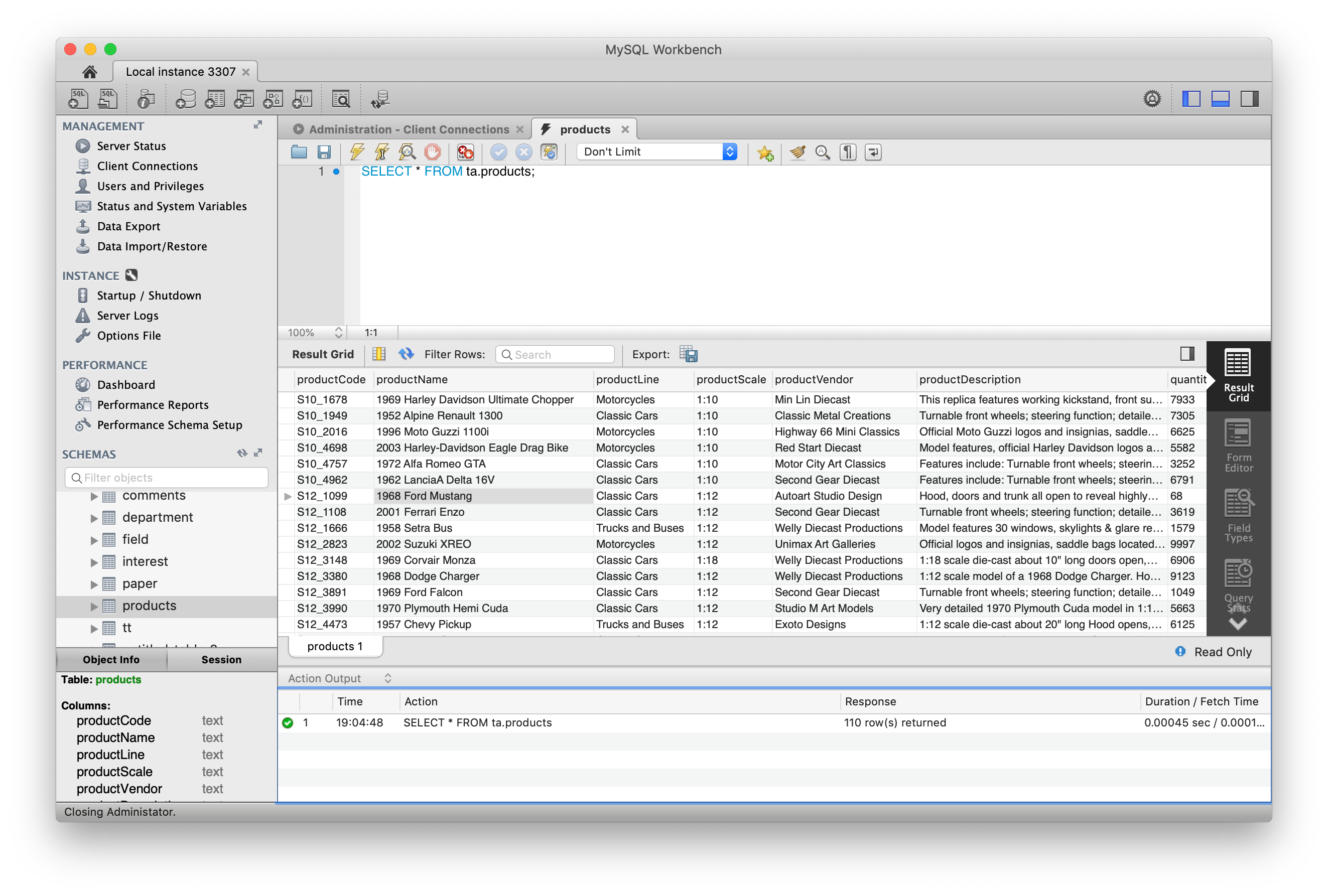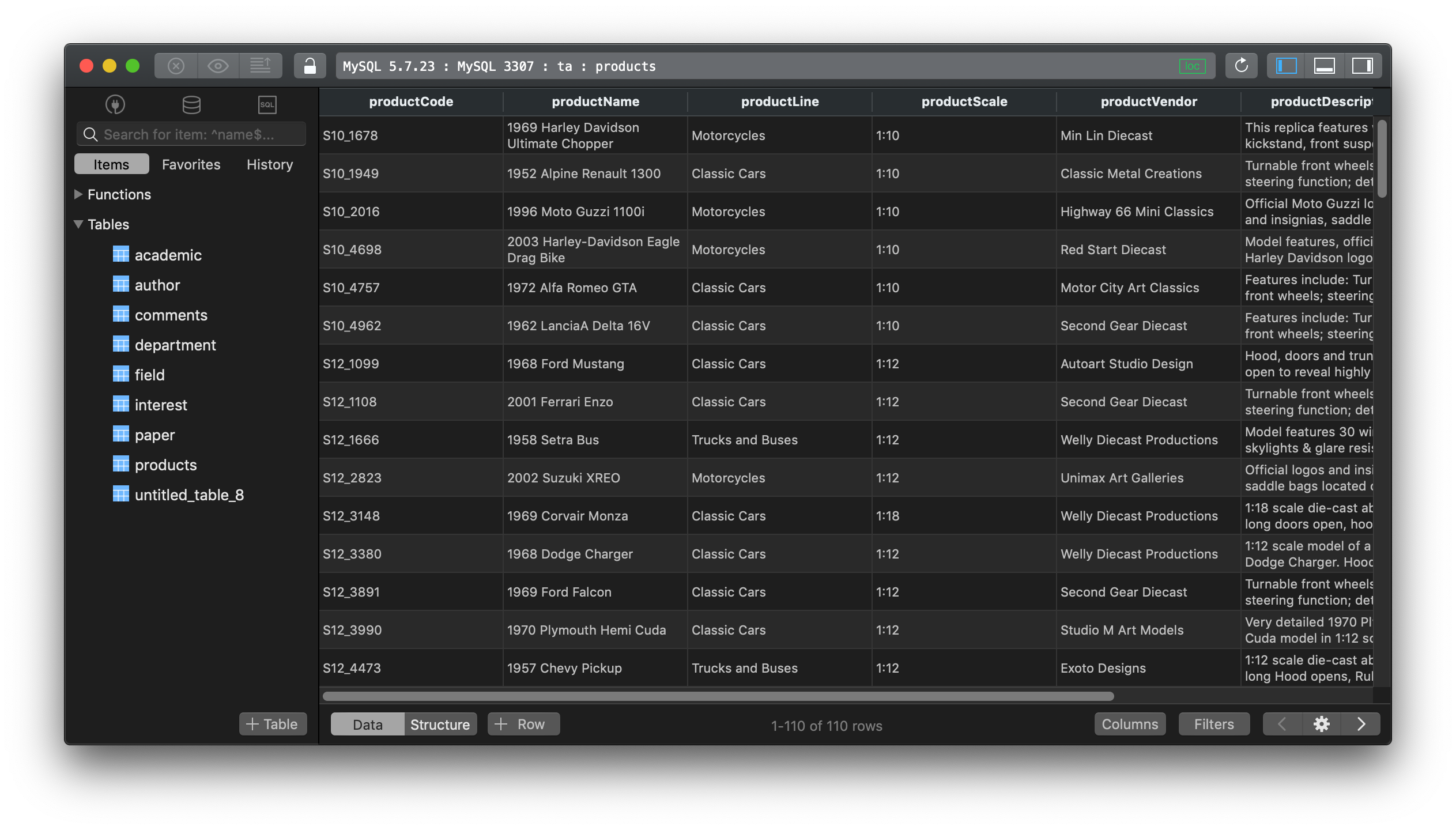phpMyAdmin vs MySQL Workbench vs TablePlus
In this post, we are going to compare three MySQL administration tools: phpMyAdmin, MySQL Workbench, and TablePlus, with pros and cons of each tool.
1. phpMyAdmin
With a web-based build, phpMyAdmin offers a handy tool to handle the administration of MySQL database in a web browser.
-
Supported platforms: phpMyAdmin is a web-based administration tool, so you can get it run from any platforms with a web browser.
-
Supported Drivers: phpMyAdmin supports MySQL 5.5 and newer.
-
Pricing: phpMyAdmin is free and open source. It’s available on almost every hosting service.

Pros:
- It’s available right out of the box in most web hosting service providers.
- It’s portable. It can run on any computer and on any OS as long as it has a web browser installed.
- Easy installation. You need to have PHP and MySQL installed on your server, extract the files to a specified directory and run the install script.
- Stable and flexible due to its maturity.
- Comprehensive management of user accounts and permissions
Cons:
- It’s web-based, so it runs slow and depends too much on the browser. Sometimes the defaults can cause conflicts with web servers.
- Confusing and outdated interface. It may take some time to get used to it.
- No schema visualization
- Does not have smart code highlighting or auto-completion capabilities.
2. MySQL Workbench
MySQL WorkBench offers a full-featured administration tool for MySQL on multiple operating systems.
-
Supported platforms: MySQL Workbench is cross-platform. It’s available on Mac, Windows, Linux.
-
Supported Drivers: MySQL Workbench supports all versions of MySQL because it’s built by the MySQL at Oracle.
-
Pricing: MySQL Workbench also has a community version which is free and open source. The other two commercial versions for enterprises are subscription based with enterprise features and support.

Pros:
- It’s cross-platform. In case you work on more than one operating system, you don’t have to use a different tool and the experiences will be consistent.
- It includes everything a data modeler needs for creating complex ER models
- It has a Visual Performance Dashboard
- A complete and easy to use tools for database migration.
- Ability to cancel long queries without hanging.
- It provides fast access to server status and other information.
- It shows multiple result sets.
- It’s easy to create and edit views, procedures & functions.
Cons:
- It only supports MySQL and MariaDB. If you work with more database other than MySQL and MariaDB, it’s a huge drawback.
- The UI is unintuitive. It is packed with a lot of features. It’s definitely not a tool for beginners.
- It complicated and overkill to perform simple tasks.
- It’s resource intensive.
- It crashes a lot too.
3. TablePlus
With a native build and a lightweight size, TablePlus is a very handy tool for managing MySQL and many other databases.
-
Supported platforms: TablePlus is built native for each platform. It started out with a native version for Mac, then another version for Windows, and a version for Linux was introduced recently as an alpha release. It also has an iOS version.
-
Supported Drivers: TablePlus supports a handful of relational databases: MySQL, PostgreSQL, SQLite, Microsoft SQL Server, Amazon Redshift, MariaDB, CockroachDB, Vertica, Oracle; and two popular NoSQL databases: Cassandra and Redis.
-
Pricing: TablePlus has a free version with full set of features which you can download and use forever, but there are some usage limitations. If you use it heavily, the license costs $59 to remove all those limitations.

Pros:
- Native build for each platform so it’s fast, lightweight, and stable.
- Clean and simple interface.
- Multiple drivers support
- Multiple conditions data filter
- Queries history and keyword binding favorite.
- Streaming results and async loading to show queries results faster and doesn’t block the UI.
- Very quick inline editing for table data and structure, you also can edit query results directly.
- Smart query editor with highlight syntax, instant autocomplete, SQL reformat.
- Multiple carets
- A plugin system to extend the app.
- Quick support. TablePlus releases new updates regularly and responds to users’ requests almost immediately.
Cons:
It currently lacks of some advanced features such as ER Diagram, database compare tool to Diff and Sync, etc.
4. Conclusion
Go with MySQL Workbench if you:
- Work with MySQL only
- Need a tool to get the job done and don’t mind the UI/UX
Go with phpMyAdmin if you:
- Work with MySQL only
- Prefer a web app over a desktop app
Go with TablePlus if you:
- Are a fan of native experience
- Work with multiple databases
- Want a modern design with better usability
- Want quick support & development cycle.